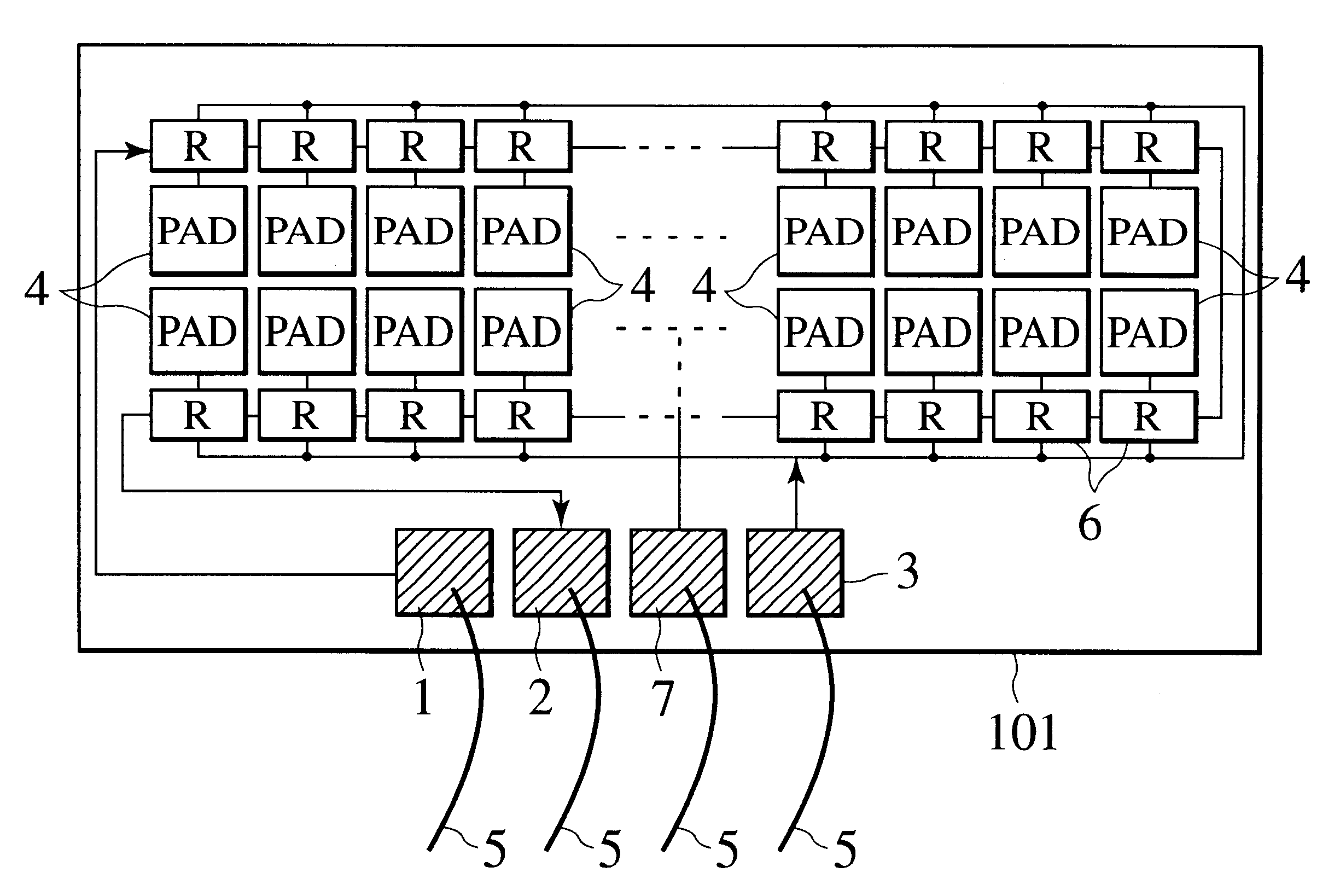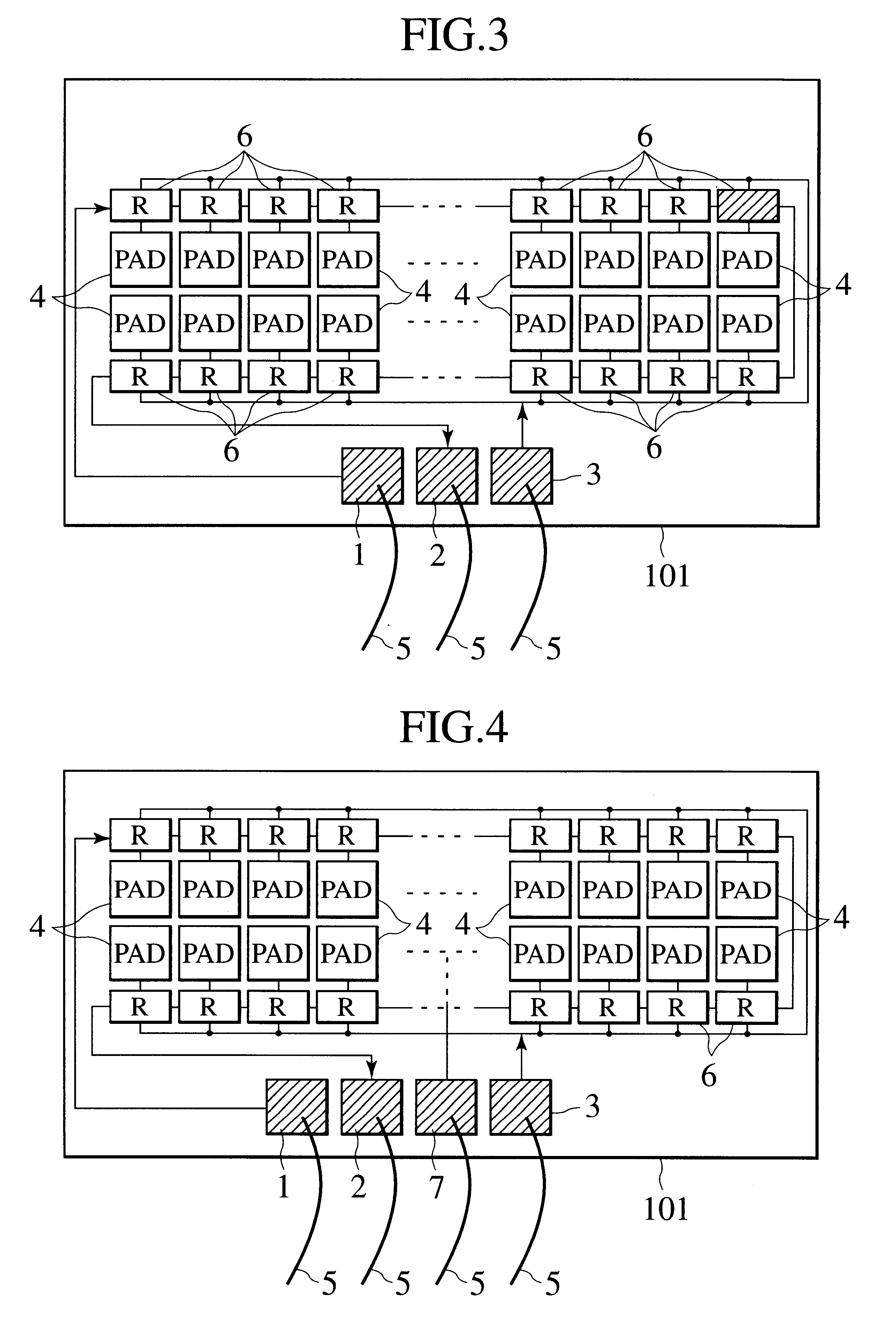Semiconductor device with test circuit
a test circuit and semiconductor chip technology, applied in the direction of solid-state devices, semiconductor/solid-state device details, instruments, etc., can solve the problems of signal skew, affecting the test accuracy, and the inability to operate at intervals of a cycle time set for the installed semiconductor chips
- Summary
- Abstract
- Description
- Claims
- Application Information
AI Technical Summary
Problems solved by technology
Method used
Image
Examples
first embodiment
FIG. 2 is a block diagram showing a semiconductor device having I / O pads according to the first embodiment of the present invention. The semiconductor device is formed on a semiconductor chip 101. At the periphery of the chip 101, a test data input pad 1, a test data output pad 2, and a test clock signal (TCK) input pad 3 are formed. The pads 1 to 3 are connected to wires 5 used for a test such as a defects analyzing test. The wires 5 may be probe-card needles, bonding wires, etc. The I / O pads 4 are in a middle part of the chip 101.
An external tester (not shown) provides test data, which is serially set in the pads 4 through the test data input pad 1. After carrying out a predetermined test, the pads 4 provide resultant data, which is passed through a serial scan chain serving as a data path and is transferred to the external tester through the test data output pad 2. A test clock signal (TCK) used to transfer the test data is supplied from the external tester to the test clock sign...
second embodiment
FIG. 8 is a block diagram showing a semiconductor device according to the second embodiment of the present invention. In FIG. 8, registers 6 and pads 4 and 41 correspond to the registers 6 forming a boundary scan chain and the pads 4 of FIG. 4. The pad 41 is a pad for which a test vector must be set according to a clock signal (CK) of a normal operation cycle time. A test vector generator 9 operating with the clock signal (CK) is arranged between the register 6 and the pad 41. The pads 4 are usual test pads having the registers 6, respectively. For the sake of simplicity of explanation, FIG. 8 shows only the pads 4 and 41 for receiving test data. For example, pads for providing test result data sent from internal circuits (not shown) to the outside are not shown in FIG. 8.
To set test data TDI in the pads 4 and 41 to carry out, for example, a defects analyzing test, an external tester (not shown) serially transfers the test data to the registers 6 of the pads in synchronization with ...
third embodiment
FIG. 9 is a block diagram showing a semiconductor device according to the third embodiment of the present invention. Each pad 41 is provided with a register group 81 containing "m" registers to supply a plurality of test vectors to the pad 41. The example of FIG. 9 has "n" pads 41 (n being a positive integer). If there are "m" test vectors, a matrix of "n.times.m" registers form a register circuit. In this case, the register circuit contains n register groups 81 each containing m registers. The register groups 81 correspond to the pads 41, respectively.
To set initial test data (TDI) in all registers of the register circuit, a multiplexer (MUX) 82 selects a test clock signal (TCK) according to a control signal TEST and supplies the selected test clock signal as a control signal A to the registers of each register group 81.
According to the control signal TEST, each multiplexer 83 receives the test data (TDI) from an external tester (not shown) and sequentially transfers the test data ...
PUM
 Login to View More
Login to View More Abstract
Description
Claims
Application Information
 Login to View More
Login to View More - R&D
- Intellectual Property
- Life Sciences
- Materials
- Tech Scout
- Unparalleled Data Quality
- Higher Quality Content
- 60% Fewer Hallucinations
Browse by: Latest US Patents, China's latest patents, Technical Efficacy Thesaurus, Application Domain, Technology Topic, Popular Technical Reports.
© 2025 PatSnap. All rights reserved.Legal|Privacy policy|Modern Slavery Act Transparency Statement|Sitemap|About US| Contact US: help@patsnap.com



